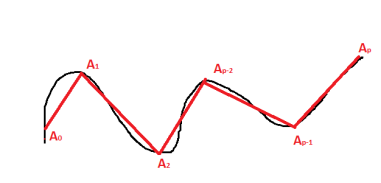Fractal concept
The fractals concept have been widely studied since their introduction by Benoît Mandelbrot(1975) in several developments and applications, which we try to give an overview. Nowadays, many researchers use them in a context far beyond the geometric aspect of their debut. Start with some fractal geometry elements seems appropriate, however, from a historical and educational point of view of all, but also from a practical point of view because geophysicist also has to solve geometric problems.
The curves we are used (lines, circles, ellipses, etc.) are rectifiable, which means that we are able to assign a length to any arc defined by two points such curves. Strictly speaking, this means that if we call
 and
and
 respectively the origin and the end of this arc, we choose
respectively the origin and the end of this arc, we choose
 consecutive points
consecutive points
 between these two points, realizing and a polygonal approximation of the arc studied.
between these two points, realizing and a polygonal approximation of the arc studied.

The length of the polygonal approximation :
tends to a finite limit, which will be the length of the arc studied simultaneously when p increases indefinitely, and that the length of the elementary segments
 tends to zero.
tends to zero.
If we ensure that basic segment
 are equal, their length then being equal to
are equal, their length then being equal to
 , that can be interpreted as a measuring gauge,
, that can be interpreted as a measuring gauge,
we will need to
 such segments to achieve the polygonal approximation and its length will be equal to:
such segments to achieve the polygonal approximation and its length will be equal to:






